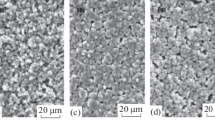Conclusions
-
1.
Zinc, applied to aluminum by the method of hot rolling (cladding), ensures longer corrosion resistance of products than when they are zinc-coated by hot dipping because in the former case the structure is homogeneous and there are no aluminum oxides in the zone of contact.
-
2.
Solders for the soft soldering of zinc-clad aluminum may contain tin, lead, or cadmium because these elements do not harm the integrity of the zinc coating in the soldered zone.
Similar content being viewed by others
Literature cited
Inventor's Certificate No. 238326 USSR. Method of Soldering Aluminum and Its Alloys.
I. N. Il'evskii, G. M. Mozhaiskaya, and I. E. Petrunin, "Corrosion resistance of soldered aluminum alloys," Fiz. Khim. Obrab. Mater., No. 5 (1968).
G. N. Smirnov, Progressive Methods of Soldering Aluminum [in Russian], Metallurgiya, Moscow (1981).
S. N. Lotsmanov (ed.) Handbook on Soldering [in Russian], Mashinostroenie, Moscow (1975).
Additional information
Technical University attached to ZIL. Translated from Metallovedenie i Termicheskaya Obrabotka Metallov, No. 12, pp. 33–35, December, 1987
Rights and permissions
About this article
Cite this article
Mozhaiskaya, G.M., Trekina, M.I. Interaction of zinc coating with aluminum and liquid metals. Met Sci Heat Treat 29, 931–934 (1987). https://doi.org/10.1007/BF00707591
Issue Date:
DOI: https://doi.org/10.1007/BF00707591



